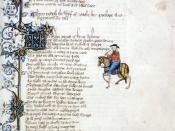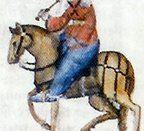ChaucerÃÂs The Canterbury Tales focuses on a group of pilgrims, contesting to tell the best tale on a pilgrimage to Canterbury. Stating two requirements for a good tale, the host says that the winner will be ÃÂthe man whose story is best told, / That is to say who gives the fullest measure / Of good morality and general pleasureÃÂ (24). By giving ÃÂgeneral pleasureÃÂ the storyteller provides an entertainment that holds the audienceÃÂs attention. For ChaucerÃÂs pilgrims, who represent the English common folk, general pleasure comes from crudity of humor, sex, and violence; romance in courtly love and gentilesse; and some connection to their own lives. By giving ÃÂgood moralityÃÂ the storyteller provides a lasting benefit by improving the audienceÃÂs understanding and wisdom. So, which story best exhibits these traits?First, is the MillerÃÂs tale. A comedic tale of the always-popular love-triangle, the MillerÃÂs tale depicts the life of John, a carpenter in Oxford, and his lovely, young wife Allison.
The other pilgrims would immediately appreciate the modesty of JohnÃÂs life and the fact that they knew where he lived. These two simple details serve to draw in the MillerÃÂs audience and make them feel more comfortable. He continues to describe aspects of life that every one of the other pilgrims would have known and experienced daily. In this way he makes them feel more connected to the story, therefore enjoying it more so. However the MillerÃÂs tale is not simply a depiction of medieval life. Quite the contrary, the Miller devises a witty plot that includes a number opportunities for Allison, the ÃÂfair young wife, [with a] body as slender / As any weaselÃÂs, and as soft and tenderÃÂ (90), to have lewd interactions with another man and even an occasion for Absalon to poke a red-hot poker up...


